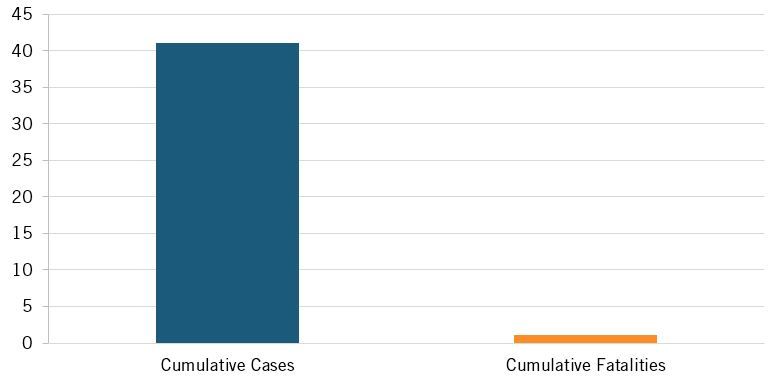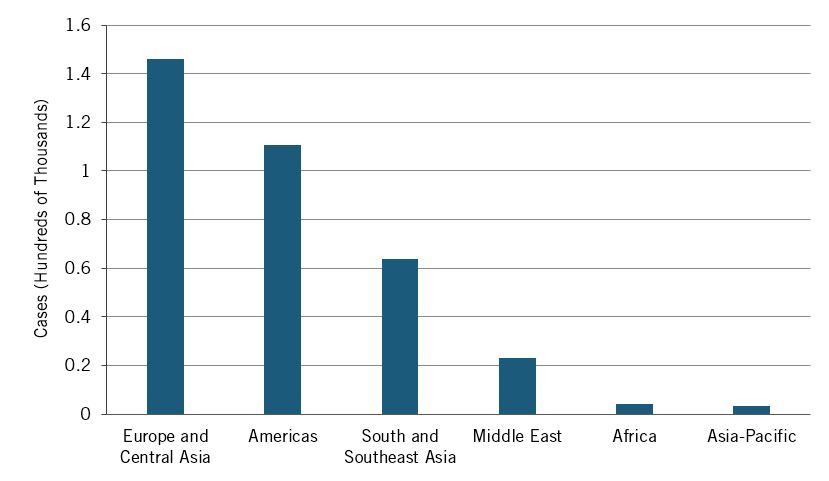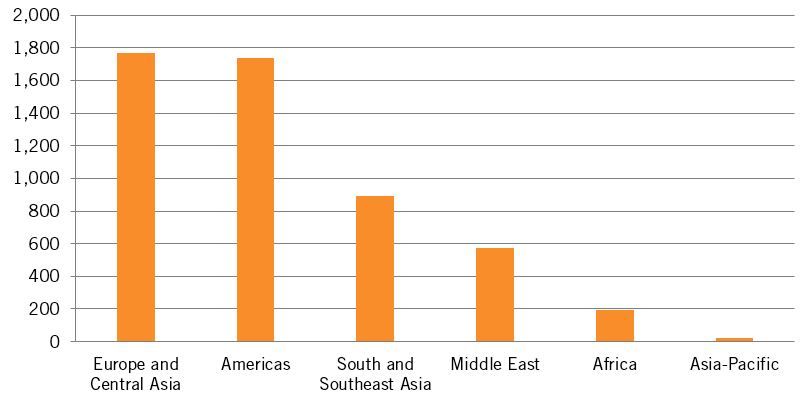GTIPA Perspectives: COVID-19 Impacts on Public Health and the Economy of GTIPA Member Nations
The COVID-19 (coronavirus) pandemic that emerged at the start of 2020 has impacted the global economy and public health to an unprecedented extent. This anthology analyzes the economic and public health impact and policy responses of 20 nations and regions.
The COVID-19 (coronavirus) pandemic that emerged at the start of 2020 has impacted the global economy and public health to an unprecedented extent. This anthology analyzes the economic and public health impact and policy responses of 20 nations and regions—Argentina, Australia, Bangladesh, the California Bay Area, Chile, Colombia, the European Union (EU), Germany, Greece, Honduras, Indonesia, Italy, Jordan, Korea, Latin America, Mexico, Poland, South Africa, the United Kingdom, and the United States—to the coronavirus pandemic. The Latin America section delves deeper into the coronavirus responses of seven additional nations: Brazil, Bolivia, Ecuador, Peru, Paraguay, Uruguay, and Venezuela. (These monographs were written over the late summer and early fall of 2020, and reflect the most-currently available data as of their time of authorship.) Before moving into the individual country case studies, however, the report starts with a brief overview of the pandemic’s broad global health and economic impacts.
Global Public Health Impact
Even approaching almost one year into the crisis, the COVID-19 pandemic continues to ravage the globe, with cases and deaths rising worldwide, with more than 5 million new cases in the past 14 days alone. As of October 21, 2020, there were over 41 million cases and deaths exceeded 1.1 million, according to the latest estimates from the World Health Organization (WHO). (See Figure 1).
Figure 1: Global COVID-19 Cases and Fatalities (millions, as of October 21, 2020)

There is substantial variation by region, however, as the Asia-Pacific region continues to see relatively minimal COVID-19 impacts, at least compared with the much-higher case and death rates being experienced in the Americas, Europe, and Central Asia. (See Figure 2 and Figure 3). The Asia-Pacific represents the lowest region with regard to all four categories of new cases, cumulative cases, new deaths, and cumulative deaths. As of October 21, the entire Asia-Pacific region experienced 3,225 new cases for a total of over 691,000 cumulative cases, and 25 new deaths for a total of almost 150,000 deaths. This compares with the Americas, which had almost 111,000 new cases for a total of 18.9 million, and 1,737 new deaths for a total of over 610,000 deaths.
Figure 2: New Coronavirus Cases by Region (as of October 21, 2020)

Figure 3: New Coronavirus Deaths by Region (as of October 21, 2020)

Europe and Central Asia are struggling as well, with a spike in recent cases and deaths surpassing even the Americas. Europe in particular now seems to be in the midst of the dreaded “second wave,” with movement restrictions and travel lockdowns beginning to reappear across the continent. In Europe and Central Asia, there were almost 146,000 new cases and 1,771 new deaths from COVID-19 on October 21, 2020. However, cumulative cases and deaths by region are much lower than in the Americas, with almost 8.4 million cases and just over 260,000 deaths.
The Middle East and Africa represent two regions that are handling the COVID-19 pandemic surprisingly well, given their relatively low levels of development and medical care compared to the industrialized world. Like the Asia-Pacific region, the Middle East and Africa have also seen relatively low levels of new cases and deaths. As of October 21, 2020, the Middle East experienced 23,000 new daily cases and Africa 4,000, while deaths were just 575 and 193, respectively. Cumulative deaths are low as well, with the Middle East having lost almost 72,000 people and Africa less than 29,000 since the pandemic started. South and Southeast Asia appear to be in the middle of the pack regarding their COVID-19 cases and deaths. On October 21, 2020, the region saw almost 64,000 new cases for a total of 8.6 million, and 891 new deaths for a total of more than 136,000. Regardless, the loss of over 1.1 million global citizens from this disease has been staggering.
Global Economic Impact
The COVID-19 pandemic has inflicted the largest shock on the global economy since the Second World War, resulting in job losses for over 500 million individuals worldwide, reduced global trade flows, and a sharp decline in gross domestic product (GDP) growth. The effects have been severe, with the global economy at the end of 2020 projected to be 8 percent smaller than it would have been in the absence of the pandemic. According to the latest edition of the World Economic Outlook released by the International Monetary Fund (IMF) earlier this month, the global economy is expected to shrink in aggregate by 4 percent in 2020, rebounding to 5 percent growth in 2021. In dollar terms, this amounts to an estimated $3.7 trillion in wealth being destroyed in 2020. Advanced economies are projected to be hit harder than the global economy on average and recover more slowly, with GDP forecast to fall almost 6 percent this year, and only rise about 4 percent next year. By contrast, the developing world is projected to see a more than 3 percent drop in GDP this year, and a surge of more than 6 percent in 2021. This leaves the developed world to deal with the economic consequences of COVID-19 after many developing nations have surpassed their pre-COVID-19 GDP peaks, resulting in diverging growth paths between the developed and developing worlds. This is evidenced by the largest distribution of growth across 50 countries in 40 years during the second quarter of this year, and the estimate that America’s economy will be the same size next year as it was in 2019, while China’s will be 10 percent larger.
Global trade is projected to fall (and subsequently rise) disproportionately to GDP growth, both this year and in 2021. The World Trade Organization (WTO) forecasts that global trade will fall by around 9 percent in 2020, rebounding to a greater than 7 percent increase next year. However, the most recent trade forecast is significantly better than the 12.9 percent drop forecasted by the WTO in April. Trade in COVID-19-related products, such as personal protective equipment (PPE), and strong trade performance in June and July due to easing lockdowns have all improved the once-dismal outlook. This is in contrast to the 14.3 percent-collapse in global trade flows experienced in the second quarter of this year, highlighting the severe economic consequences of the lockdowns initiated around the world. However, the projected surge of trade next year has also been dampened from an original 21.3 percent growth estimate, due to new data on potentially weak pent-up demand and restocked business inventories. Overall, global trade was heavily impacted by COVID-19. International cooperation and internal stimulative policies will be necessary to ensure that trade growth is revived post-COVID-19.
Governments around the world have increased spending to combat the fall in aggregate demand resulting from the pandemic. Globally, fiscal measures to combat the coronavirus amount to 6 percent of global GDP. Among advanced economies, fiscal stimulus so far this year has amounted to almost 8 percent of GDP on average, compared with an average of 2.5 percent of GDP in the developing world. Within the European Union, increased stimulus amounts to slightly less than 4 percent of GDP, highlighting the fiscal benefits of early and aggressive counter-measures to combat the pandemic. Nevertheless, already by the end of April, the European Union had approved more than €2.2 trillion ($2.6 trillion) in state aid. In the United States, measures to tackle the virus have been piecemeal and ad-hoc, yet still the total value of U.S. COVID-19 fiscal stimulus packages is now equivalent to 13.2 percent of the country’s GDP.
The COVID-19 Country Case Studies
With that summary introduction, this report now proceeds to the country COVID-19 case studies. For each nation covered, this report examines the public health impact of the coronavirus in terms of infections, fatalities, and recoveries and documents public health responses nations have taken, including everything from diagnostic and testing approaches, to the preparations of hospitals and intensive care unit (ICU) beds, to nations’ efforts to develop coronavirus diagnostic kit and tests, therapeutic drugs, and vaccines to their plans to disseminate them to domestic and global audiences. Equally, the report examines the impact of the pandemic on nations’ economies in terms of GDP and employment effect, industrial output, and changes in trade flows. It considers both demand- and supply-side effects as well as business and consumer impacts. It also examines the economic and regulatory policy responses these nations have introduced in responding to the crisis.
The report considers both nations’ short- and long-term responses to the pandemic, and pays particular attention to how nations, once the world gets through the pandemic, can position themselves for higher levels of greater long-term economic growth. In the short-run, the report notes that the coronavirus pandemic has exerted a massive supply-side shock; in other words, the global economy was fairly robust going into the crisis, but the subsequent lockdowns and impediments to productive work and enterprise introduced a supply-side shock that cratered production and employment, leading to layoffs that propagated global demand-side declines, thus leading to a vicious cycle of reduced supply and demand amidst widespread global uncertainty which collectively tremendously reduced global growth. Only did massive fiscal and monetary interventions from nations worldwide, including income support for citizens, stabilize the situation. However, the most-sophisticated countries in terms of responding to the crisis, such as Austria and Germany, recognized that a key point of intervention was working with companies to develop or to provide needed safety equipment and protocols to keep production environments safe for workers, so that enterprise and employment could sustain. Those two countries also quickly turned to re-implement their short work or “Kurzarbeit” schemes (as they had during the Great Recession) in which employees work reduced hours (perhaps 80-90 percent of normal) with state or federal governments chipping in the difference and often those hours being used for educational or retraining opportunities. Equally, nations that had significantly advanced digital infrastructures could transition a significant amount of productive output (especially in services industries) to the home and virtual environments.
In terms of better positioning nations for longer-term economic growth, additional examples from the case studies include countries’ efforts to redouble deployment of digital infrastructure such as high-speed broadband Internet and next-generation mobile networks as well as to make greater embrace of digital applications such as e-government, telemedicine, tele-education, intelligent transportation systems, and contactless payment systems. The report also finds that many nations and regions are using the crisis as an opportunity to sweep away low-value-adding regulations that impede the deployment of digital technologies, such as restrictions on the use of automated grocery checkout, robots, drones, or autonomous vehicles.
Unfortunately, the pandemic has led countries to consider introducing a range of trade restrictions, from export controls on medical equipment, PPEs, and pharmaceuticals to renewed efforts from a variety of nations to indigenize supply chains, reshore production activity for critical goods like pharmaceuticals and medical supplies, or to adopt local procurement requirements. In fact, the IMF has identified over 120 new such export restrictions over the course of 2020.
However, as a global consortium of think tanks (many represented in this volume) argued in the report, “A Joint Declaration on the Importance of Collaboration, Open Trade, and Innovation in Tackling COVID-19,” (and reiterate throughout this report), international collaboration and open trade will be vital if nations and their citizens are to get through this pandemic. That report calls for the world’s governments to commit to embracing the following seven collaborative actions to address the pandemic: 1) Abolish tariffs on medical supplies and medicines; 2) Reject export bans on medical supplies; 3) Reduce customs red tape; 4) Enable the free flow of relevant health data across borders; 5) Maintain transparency in collecting and sharing epidemiological data; 6) Increase cooperation with other countries to speed up drug approval; and 7) Support innovation, including by recognizing and protecting intellectual property rights.
The coronavirus represents a global problem; therefore, it’s going to require a collaborative global solution. Indeed, global cooperation is needed now more than ever to effectively respond to the economic and public health challenges the coronavirus will wreak into 2021 and beyond. How the global community responds to this crisis will set the course for how the rest of this century unfolds: as one of greater collaboration among nations, or one where global economy and society become increasingly fractured along ideological, political, and regional lines. The members of the Global Trade and Innovation Policy Alliance call upon global policymakers to choose the more-enlightened path.

